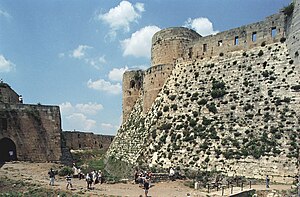Talus (fortification)
This articleneeds additional citations forverification.(February 2022) |
 TheKrak des Chevaliersin Syria, with a tall and clearly defined talus |
Inarchitecture,thetalusis a feature of somelate medievalcastles,especially prevalent incrusaderconstructions. It consists of abattered(sloping) face at the base of afortified wall.
Feature
[edit]The slope acts as an effective defensive measure in two ways. First, conventional siege equipment is less effective against a wall with a talus.Scaling laddersmay be unable to reach the top of the walls and are also more easily broken due to the bending stresses caused by the angle they are forced to adopt.Siege towerscannot approach closer than the base of the talus, and theirgangplankmay be unable to cover the horizontal span of the talus, rendering them useless. Furthermore, defenders are able to drop rocks over the walls, which will shatter on the talus, spraying a hail ofshrapnelinto any attackers massed at the base of the wall.[1]
 The walls of the citadel ofTughlaqabad FortinDelhi,India. The walls and towers are reinforced with a solid talus. |
 |
See also
[edit]References
[edit]Further reading
[edit]- Chisholm, Hugh,ed. (1911)..Encyclopædia Britannica.Vol. 26 (11th ed.). Cambridge University Press. p. 386.
- James, Charles (1805),A New and Enlarged Military Dictionary,T. Egerton, pp.227–228,908
